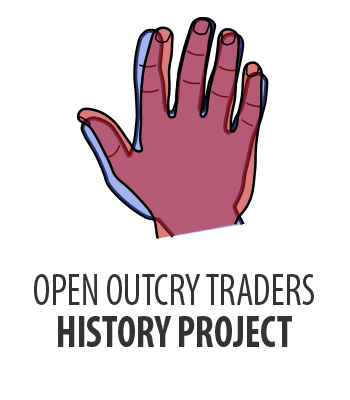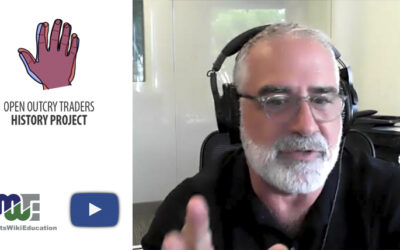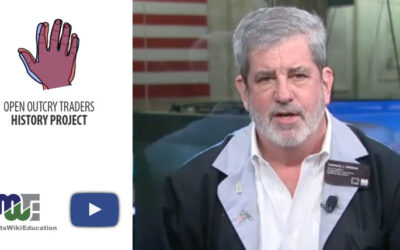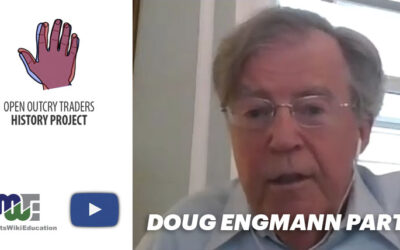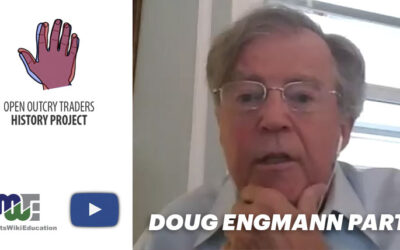TRADER LARRY ABRAMS TALKS ABOUT HIS CAREER FOR THE OPEN OUTCRY TRADERS HISTORY PROJECT
In part two of the JLN MarketsWiki Education Open Outcry Traders History Project interview with Larry Abrams, he talks about the emotionally draining market openings every day, his rather ugly experience in Kansas City opening a futures trading operation for Cooper Neff, options exercised out of the money, electronic trading, economic opportunity (and small worlds) and being a magician.
Abrams said openings were an emotional experience in which he became more uncomfortable as time ticked down to the opening. He said there was nothing like it and the “massive amount of energy expended” as the market roared open.
His strategy for openings was to keep a focus on nearby brokers rather than the whole pit. There was a certain chemistry he built with the brokers near his 1 foot (or 8 inches) of real estate in the trading pit. Abrams said the integrity of the brokers in the pits he traded in was very high and that they would not tip off information to traders in the pits.
He said it was not his experience that traders and brokers took care of each other if they had errors or for other reasons. He did say brokers would sometimes hit him or other traders with a large trade, knowing the traders will portion it out to fellow locals. The broker would have done the same thing if they had the time.
Abrams had an ugly experience at the Kansas City Board of Trade when he moved to Kansas to set up a futures trading operation before he moved to Chicago. He said the traders there were an “old boy network” with histories running back generations at the exchange.
He said the traders he met at the KCBT were “anti-Semitic” and called him names, including calling him a “New York Jew” even though he had moved from Philadelphia. The traders in the Value Line futures pit would ignore trades and even put “bad out-trades” to him as a test.
There was another trader from out east for Philadelphia Trading, which later became Susquehanna, who also did not fit the old boy Kansas City description.
One day Abrams was called out of the pit to get on the phone with his head trader at the Philadelphia Stock Exchange where they traded the Value Line index options. The head trader gave him an order to sell 600 Value Line futures contracts, which would be the biggest trade ever to be seen in the pit. Cooper Neff had done a large trade in the Value Line index options and needed to hedge it with futures.
Not wanting to show his hand, Abrams walked into the pit and asked what was there. The Philly trader said, “50 bid.” Abrams said, “Sold.” The trader asked how many. “One hundred,” Abrams said. Then Abrams asked again, “What is there?” The trader said, “50 bid.” Abrams said, “Sell you 500 at 40.” The trader said, “Sold.”
Quickly all the traders in the pit who had witnessed this monstrous trade (by KCBT standards at the time) rushed both traders and called them every name in the book and accused them of pre-arranged trading. Exchange security showed up and removed them from the trading floor. The head of the CFTC office in Kansas City, across the street from the exchange, came over and interrogated them about the trade.
Abrams and the other trader were barred from trading for 10 days while the matter was investigated, but it turned out the trade was “totally legit,” Abrams said. He said the environment in the trading pit was “incredibly hostile” and it could have turned out badly had security not shown up when they did.
Abrams was very fearful of outtrades and would always employ two trade checkers to check his trades so he would find out faster than he would getting the information from the clearing firm or clearinghouse.
He talked about a couple of instances when out-of-the-money options were exercised, giving the options traders a huge windfall. In one instance, it was a Refco trader who Abrams said exercised the out-of-the-money options on purpose. When the market did not move in the direction the trader wanted, he said the options were exercised in error and pressured his pit broker to get the traders who benefitted to write checks to him for the error. Even though Abrams was not sure this could be done legally three days afterwards, it turned out it could and so he did.
Another time, the famed trader Richard Dennis exercised some out-of-the-money options and, Abrams said, “took a shot.” Dennis owned up to the exercise and did not try to get the money back.
Abrams said the life lessons he learned included the unofficial motto of the Chicago Board of Trade, “Your word is your bond.” He also said he really learned how to read people. And he learned discipline and its importance.
He would try to leave the experience of the trading pit “on the field” and not carry it home. He was a competitor, but he learned to remove himself from the game when he couldn’t play. He knew when the game was bigger than him.
Abrams started to pay attention to electronic trading from a personal investment standpoint, though he thought for many years that the exchange’s future was in doubt. He said the CBOT’s extinction was two years away for 15 years, miscalculating how long it would take electronic trading to overcome open outcry trading.
We shot a second video with Abrams after he remembered a story he said should be included in his interview. The subject was economic opportunity. He told the story of when he was trading at the CBOE as one of the “boat people,” traders who would go from pit to pit where there was good activity. UAL was in the midst of a buyout, however it fell apart over a weekend that also happened to coincide with Abrams’ wife going into labor with their first child.
For three days in the hospital Abrams was by his wife while also trading over the phone. He would be chided for years by other traders for having missed three of the greatest trading days ever. On the subject of small worlds, Abrams’ son now works for United Airlines.
Also, today Abrams volunteers at that hospital as a magician as part of Open Heart Magic, a non-profit organization of magicians who perform for children.
There are about 150 magicians in Open Heart Magic and it takes 13 weeks of classes to become a member. Abrams said it takes the same traits to be a magician as a trader: lots of concentration and “relaxed perfection.”
Abrams will often travel with his red sponge balls and perform tricks for strangers he sees, wowing them with magic.
If you want to learn more about Open Heart Magic, want to learn how to become a magician, support the organization or have Abrams show you a trick, please feel free to reach out to him.
